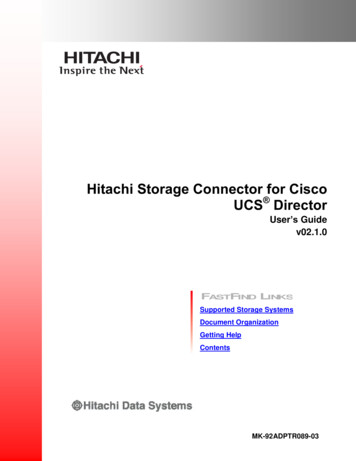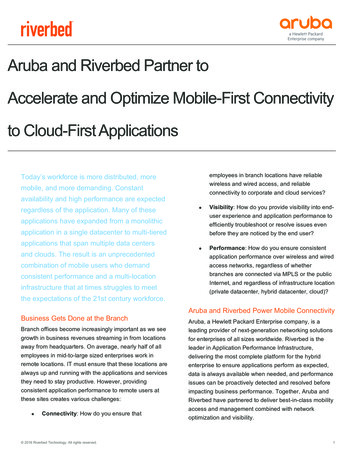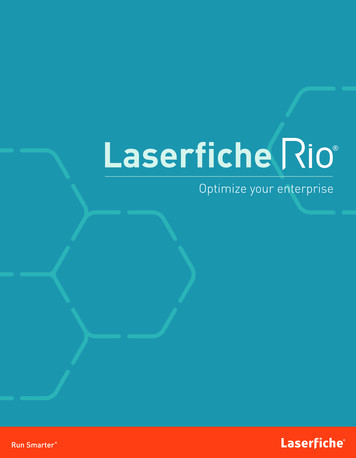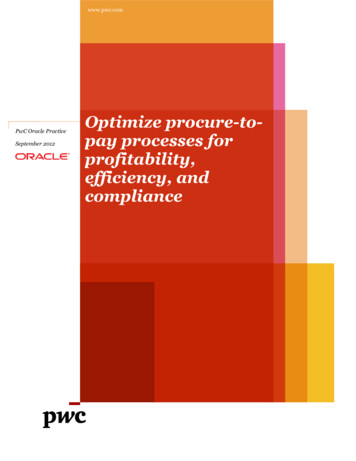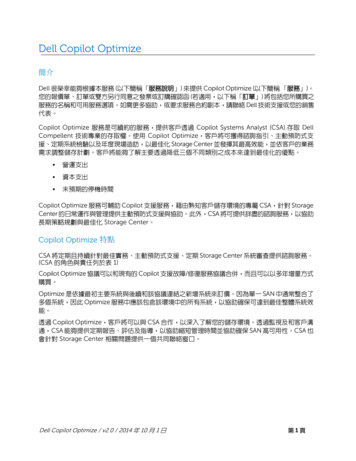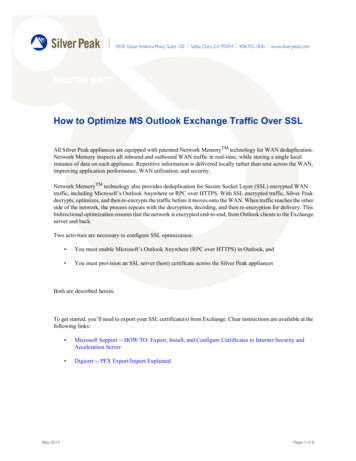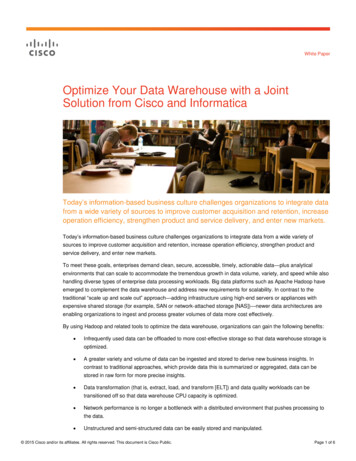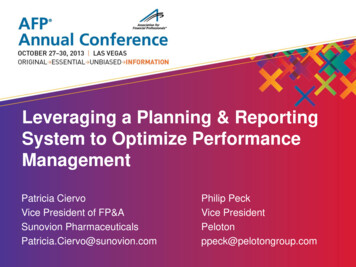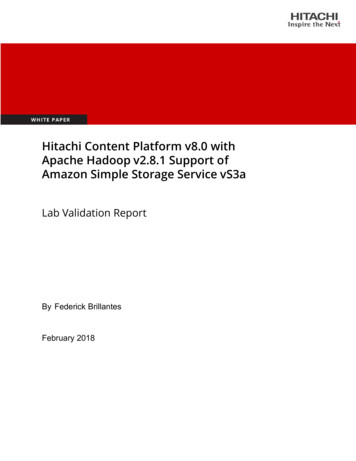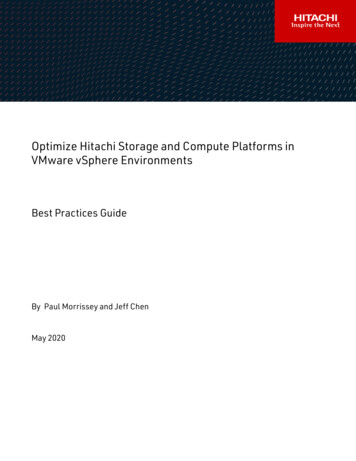
Transcription
Optimize Hitachi Storage and Compute Platforms inVMware vSphere EnvironmentsBest Practices GuideBy Paul Morrissey and Jeff ChenMay 2020
FeedbackHitachi Vantara welcomes your feedback. Please share your thoughts by sending an email message toSolutionLab@HitachiVantara.com. To assist the routing of this message, use the paper number in the subject and the title ofthis white paper in the text.Revision HistoryRevisionChangesDateMK-SL-145-00Initial releaseMarch 26, 2019MK-SL-145-01Updates for new Hitachi Virtual Storage Platform models and new softwareMay 8, 2020MK-SL-145-02Updated with latest storage models/capabilities, vSphere 7, and addedhelpful blog referencesMay 15, 2020
Table of ContentsHitachi Ecosystem Adapters for VMware Environments4Hitachi Storage Provider for VMware vCenter (VASA and vVols)4Hitachi Infrastructure Management Pack for VMware vRealize Operations4Hitachi Storage Connector for VMware vRealize Orchestrator4Hitachi Storage Content Pack for VMware vRealize Log Insight5Hitachi Storage Plug-in for VMware vCenter5Hitachi Infrastructure Adapter for Microsoft Windows PowerShell5Hitachi Storage Replication Adapter for VMware Site Recovery Manager5Hitachi Data Instance Director Adapter for VMware Site Recovery Manager5Hitachi Data Instance Director Connector for VMware vRealize Orchestrator5Hitachi United Compute Platform Advisor6VMware vSphere Storage APIs — Array Integration6Hitachi SAN and VMware Configuration Best Practices7LUN and Datastore Provisioning Best Practices7Zoning10Multipathing11Hitachi Storage (VASA) Provider Enabling Virtual Volumes (vVols)12Clustered VMDK with vSphere 7.017iSCSI17VMware vSphere Storage Optimizations and Capacity Management18Hitachi Storage Resource Management20VMware Site Recovery Manager Best Practices23VMware vSphere Metro Storage Cluster with Global-Active Device Best Practices243DC with VMware Site Recovery Manager Best Practices25VMware Cloud Foundation and External Storage27Kubernetes and Persistent storage with Hitachi28Referenced Infrastructure Products28
1Optimize Hitachi Storage and Compute Platforms in VMwarevSphere EnvironmentsBest Practices GuideHitachi Vantara LLC, a subsidiary of Hitachi, Ltd., provides various datacenter infrastructure components to enable ITenvironments to support a VMware ecosystem. This includes midrange and enterprise storage, converged, andhyperconverged infrastructure as well as a suite of software and software integrations to enable a robust automatedoperational environment.This document outlines most of the best practices to implement in a VMware server virtualization, desktop, or cloudenvironment with Hitachi storage or a converged Hitachi Unified Compute Platform (UCP). This includes the associatedsoftware integrations into various VMware vCenter and vRealize management stacks. This aids building a VMwareenvironment that provides the performance, scalability, reliability, usability, resilience, and recoverability expected whenpaired with Hitachi products.Hitachi is an Elite Partner in VMware’s Technology Alliance Partner program, a participant in VMware Ready Partnerprograms for Storage Infrastructure Services, and a Global OEM partner. Together, Hitachi and VMware are committed toproviding innovative, business-enabling technology, with end-to-end virtualization solutions for the datacenter.These best practices cover the Hitachi storage and converged products listed in Table 1, “Hitachi Storage and ConvergedSystems,” on page 2.1
2TABLE 1. HITACHI STORAGE AND CONVERGED SYSTEMSHardwareStorageProductHitachi Virtual Storage Platform (VSP) 5000 series Virtual Storage Platform 5100 Virtual Storage Platform 5500 Virtual Storage Platform 5100H Virtual Storage Platform 5500HHitachi Virtual Storage Platform E series Virtual Storage Platform E990Hitachi Virtual Storage Platform F series Virtual Storage Platform F1500 Virtual Storage Platform F900 Virtual Storage Platform F700 Virtual Storage Platform F370 Virtual Storage Platform F350Hitachi Virtual Storage Platform G seriesConverged Systems Virtual Storage Platform G1500 Virtual Storage Platform G900 Virtual Storage Platform G700 Virtual Storage Platform G370 Virtual Storage Platform G350Hitachi Unified Compute Platform HCHitachi Unified Compute Platform CIHitachi Unified Compute Platform RSCisco and Hitachi Adaptive Solutions for Converged InfrastructureCisco and Hitachi Adaptive Solutions for SAP HANA Tailored DataCenter IntegrationSome of the Hitachi software products covered by these best practices are listed in Table 2, “Hitachi Software, Plugin, andAdapter Products,” on page 3.2
3TABLE 2. HITACHI SOFTWARE, PLUGIN, AND ADAPTER PRODUCTSSoftwareHitachi Adapters, Plugins andsoftware for VMwareEcosystemProductHitachi Storage Provider for VMware vCenter (VASA)Hitachi Infrastructure Management Pack for VMware vRealizeOperations (vROPS)Hitachi Storage Connector for VMware vRealize Orchestrator (vRO)Hitachi Storage Content Pack for VMware vRealize Log Insight (vRLI)Hitachi Storage Plug-in for VMware vCenter (vCenter)Hitachi Infrastructure Adapter for Windows PowerShell (PowerCLI)Hitachi Storage Replication Adapter (SRA)Hitachi Data Instance Director Adapter for VMware Site RecoveryManager (SRA)Hitachi Data Instance Director Connector for VMware vRealizeOrchestrator (vRO)Hitachi Unified Compute Platform Advisor (UCP Advisor)Hitachi Storage SoftwareHitachi Storage Virtualization Operating System RF (SVOS RF): Hitachi Dynamic Provisioning (HDP) Hitachi Dynamic Tiering (HDT) Hitachi Thin Image (HTI) Hitachi ShadowImage Hitachi TrueCopy Hitachi Universal Replicator (HUR) Global-active device on Virtual Storage Platform Remote replication extended (for 3DC scenarios) Hitachi Ops Center Analyzer (formerly Hitachi InfrastructureAnalytics Advisor) Hitachi Ops Center Automator (formerly Hitachi AutomationDirector) Hitachi Ops Center Protector (formerly Hitachi Data InstanceDirector3
4Note — Testing to develop these best practices was in a lab environment. Many things affect production environmentsbeyond prediction or duplication in a lab environment. Follow the recommended practice of conducting proof-ofconcept testing for acceptable results in a non-production, isolated test environment that otherwise matches yourproduction environment before your production implementation of this solution.Hitachi Ecosystem Adapters for VMware EnvironmentsThe suite of Hitachi ecosystem adapters for VMware environments enables you to provision, manage, monitor, and operateHitachi infrastructure within the single pane of glass experience provided by the VMware management stack. It is a bestpractice to leverage these integrations to simplify, automate and efficiently operate VMware virtualization or cloudenvironments that leverage Hitachi storage and Hitachi converged solutions.Documentation on all of these Hitachi and VMware software integrations available on this VMware page from HitachiVantara Support. Download the integrations from VMware Adapters on Hitachi Vantara Support (user credentials required)or Hitachi Vantara on the VMware Solution Exchange (no credentials required).A short summary of these integrations follows.Hitachi Storage Provider for VMware vCenter (VASA and vVols)Use Hitachi Storage Provider for VMware vCenter to enable storage-aware tagging services for VMFS and/or enableVMware vSphere Virtual Volumes (vVols) for a software-defined hardware-enabled Hitachi storage infrastructure. Thisenables efficient provisioning and usage of storage and VMDK resources based on application-specific data services, suchas snapshot, encryption, replication, and so forth. Ultimately, reduce the operational burden shared by the virtualinfrastructure administrator and the storage administrator with this storage provider.For more information, see VMware vSphere Virtual Volumes (vVols) with Hitachi Virtual Storage Platform Quick Start andReference Guide.Hitachi Infrastructure Management Pack for VMware vRealize OperationsHitachi Infrastructure Management Pack for VMware vRealize Operations (vROPS) (formerly Hitachi Storage ManagementPack for VMware vRealize Operations) integrates metrics and alerts from physical and virtual layers to help you manage thehealth, capacity and performance of your Hitachi storage or converged infrastructure deployments in VMwareenvironments. It significantly enables efficient resource utilization and proactive troubleshooting to reduce operationalcosts leveraging the provided dashboards, metrics, and correlated alerts. For more information, see the InfrastructureManagement Pack for VMware vRealize Operations user guide.Hitachi Storage Connector for VMware vRealize OrchestratorAutomate and orchestrate various workflow tasks on Hitachi storage supporting both block and file. Extend the capabilitiesof VMware vRealize Orchestrator with Hitachi Infrastructure Connector for VMware vRealize (formerly Storage Connectorfor VMware vRealize Orchestrator) by providing access to over 130 foundational Hitachi storage-specific workflows. Formore information, see Storage Connector for VMware vRealize Orchestrator.4
5Hitachi Storage Content Pack for VMware vRealize Log InsightHitachi Infrastructure Content Pack for VMware vRealize Log Insight (formerly Storage Content Pack for VMware vRealize)delivers real-time log analysis and better troubleshooting across physical and virtual infrastructures. It simplifiessearching for errors by collecting and grouping information to show important, relevant, and useful events. You areprovided a comprehensive view into Hitachi storage systems, enabling spotting potential issues and keeping track ofcomponents that show departure from normal operations. For more information, see Hitachi Storage Content Pack forVMware vRealize Log Insight.Hitachi Storage Plug-in for VMware vCenterUsing Hitachi Storage Plug-in for VMware vCenter integrates management of Hitachi Storage systems within the VMwarevCenter console. This allows your VMware vCenter administrator to provision and manage datastores with essentialconfiguration options from Hitachi Storage systems. Use this plug-in to provide visibility into mapping of datastores toHitachi storage system resources. For more information, Hitachi Storage Plug-in for VMWare vCenter.Hitachi Infrastructure Adapter for Microsoft Windows PowerShellHitachi Infrastructure Adapter for Microsoft Windows PowerShell provides an extensive range of cmdlets to automate manystorage resource and data services options. Admins can use these cmdlets as part of PowerShell experience. For moreinformation, see Storage Adapter for Microsoft Windows PowerShell.Hitachi Storage Replication Adapter for VMware Site Recovery ManagerVMware vCenter Site Recovery Manager automates the disaster recovery and testing process using either host or storagebased replication. Hitachi Storage Replication Adapter (SRA) is the software interface that integrates Hitachi Storagesystems and its replication software with VMware vCenter SRM processes. Used together, VMware vCenter SRM andHitachi Storage and software provide an automated and seamless disaster recovery solution within the VMware vCenterinfrastructure. See Block Storage Replication Adapter for VMware vCenter Site Recovery Manager.Hitachi Data Instance Director Adapter for VMware Site Recovery ManagerHitachi Data Instance Director Adapter for VMware Site Recover Manager provides a higher level of automation forconfiguration of local and remote replication relationships between primary and secondary systems. This adapter is like theadapter referenced above. This adapter is compatible with Hitachi Ops Center Protector environments that manage all thepausing, swapping, and resuming of the associated replication pairs that VMware vCenter Site Recovery Manager mayrequire. Deploy this adapter independently from the adapter referenced above. For more information, see Data InstanceDirector Adapter for VMware Site Recovery Manager.Hitachi Data Instance Director Connector for VMware vRealize OrchestratorHitachi Data Instance Director Connector for VMware vRealize Orchestrator enables you to include Hitachi Ops CenterProtector storage hardware offload-based services such as virtual machine level backup, restore, and copy datamanagement functionality in their vRealize Orchestrator workflows. The workflows currently supported include backupand restore of virtual machines, clone virtual machines from prior snapshots, and mount VMDKs from snapshots to anyvirtual machines. These vRealize Orchestrator operations can be performed from the VMware vCenter user interface usingthe packaged XML imported into vCenter. For more information, see Data Instance Director Connector for VMWare vRealizeOrchestrator.5
6Hitachi United Compute Platform AdvisorHitachi Unified Compute Platform Advisor (UCP Advisor) brings simplified IT administration to virtualized, converged, andhyperconverged systems from Hitachi. Unified Compute Platform Advisor supports guided life-cycle management to theserver, network, and storage elements within supported Unified Compute Platform systems.Unified Compute Platform Advisor is used to discover and provision servers initially, and later to manage the computenodes: Identify Unified Compute Platform servers for remote management. Provision servers. Image the custom BIOS settings on the server Install the operating system. Upgrade the installed firmware, Power cycle a compute node remotely. Launch a remote console for a server. Provides remote access to general system information.VMware vSphere Storage APIs — Array IntegrationVMware vSphere Storage APIs — Array Integration (VAAI) allow VMware vSphere environments to use advanced features ofHitachi storage arrays. Using vSphere Storage APIs provide a way to use those advanced storage capabilities from withinthe VMware interface. Processing is directly on the storage infrastructure.These performance enhancements move the I/O load from the dependent VMware vCenter host platform into the storagecontroller. By offloading storage related operations off to the storage subsystem, it speeds up the datastore and VMDKprovisioning operations. This frees virtualization management for more critical tasks.When used with VMware vSphere 5.x and 6.x, Hitachi storage supports the following API primitives: Full copy — This primitive enables the storage system to make full copies of data within the storage system withouthaving the VMware ESXi host read and write the data. Block zeroing — This primitive enables storage systems to zero out many blocks to speed provisioning of virtualmachines. Hardware-assisted locking — This primitive provides an alternative means to protect the metadata for VMFS cluster filesystems, thereby improving the scalability of large VMware ESXi host farms sharing a datastore. Thin provisioning stun — This primitive enables the storage system to notify the VMware ESXi host when thinprovisioned volumes reach certain capacity utilization threshold. When enabled, this allows the ESXi host to takepreventive measures to maintain virtual machine integrity. UNMAP — This primitive enables a VMware ESXi host to inform the Hitachi storage array that space can be reclaimedthat previously had been occupied by a virtual machine that has been migrated to another datastore or deleted.6
7Hitachi SAN and VMware Configuration Best PracticesA well-designed SAN must be reliable and scalable and recover quickly in the event of a single device failure. Also, a welldesigned SAN grows easily as the demands of the infrastructure that it serves increases. The focus of this best practiceguide is on environments that leverage SAN-based datastores. If you use Hitachi NFS datastores, consult Hitachi NASPlatform Best Practices Guide for NFS with VMware vSphere (MK-92HNAS028-01 or later, PDF).Hitachi storage uses Hitachi Storage Virtualization Operating System RF (SVOS RF). Find general documents in StorageVirtualization Operating System covering volume management, security replication. Following are specific advice forVMware environments using Storage Virtualization Operating System. This guide covers VMware vSphere 6.x and 7.0environments at time of publication.Virtual Volumes (vVols)Virtual Volumes (vVols) covered in detail in “Hitachi Storage (VASA) Provider Enabling Virtual Volumes (vVols)” on page 12.Follow the guidance covered in VMware vSphere Virtual Volumes (vVols) with Hitachi Virtual Storage Platform Quick Startand Reference Guide.LUN and Datastore Provisioning Best PracticesThese are best practices for general VMFS provisioning. Hitachi recommends that you always use the latest VMFS version.Always separate the VMware cluster workload from other workloads.LUN SizeThe following lists the current maximum LUN/datastore size for VMware vSphere and Hitachi Storage: The maximum LUN size for VMware vSphere 6.x or 7.0 is 64 TB. The maximum LUN size for Hitachi Virtual Storage Platform F series or VSP G series is 256 TB with replication. The LUN must be within a dynamic provisioning pool. The maximum VMDK size is 62 TB (vVol-VMDK or RDM)Using multiple smaller sized LUNs tend to provide higher aggregated I/O performance by reducing the concentration of astorage processor (MPB). It also reduces the recovery time in the event of a disaster. Take these points into consideration ifusing with larger LUNs. In some environments, the convenience of using larger LUNs might outweigh the relatively minorperformance disadvantage.Prior to Hitachi Virtual Storage Platform E series, VSP F series, and VSP G series systems, the maximum supported LUN sizewas limited to 4 TB because of storage replication capability. With current Hitachi Virtual Storage Platform, this limitationhas been removed. Keep in mind that recovery is typically quicker with smaller LUNs. So, use the appropriate size thatmaximizes usage of MPB resources per LUN for workload. Use the VMware integrated adapters or plugins Hitachi Vantaraprovides, such as vSphere Plugin, Microsoft PowerShell cmdlets or VMware vRealize Orchestrator workflows to automatedatastore and LUN management.7
8Thin-Provisioned VMDKs on a Thin-Provisioned Datastore from Dynamic ProvisioningPoolThin provisioned VMDKs on thin provisioned LUNs or datastores has become the more common storage configuration forvirtualized environments. With Hitachi Dynamic Provisioning, a part of Hitachi Virtual Storage Operating System RF,provision thin LUNs or datastores with less physical storage capacity. However, monitor storage usage closely to avoidrunning out of physical storage capacity. The following are some storage management and monitoring recommendations: Hitachi Infrastructure Management Pack for VMware vRealize Operations provides dashboards and alerting capabilityfor monitoring physical and logical storage capacity Enable automatic UNMAP with VMFS 6 (scripted UNMAP command with VMFS 5) to maintain higher capacity efficiencyRDMs and Command DevicesIf presenting command devices as RDMs to virtual machines, ensure command devices have all attributes set beforepresenting it to VMware ESXi hosts.LUN DistributionThe general recommendation is to distribute LUNs and workloads so that each host has 2-8 paths to each LDEV. Thisprevents workload pressure on a small set target ports to become a potential performance bottleneck.It is prudent to isolate production, and critical systems to dedicated ports to avoid contention from other hosts workloads.However, presenting the same LUN to too many target ports could also introduce additional problems with slower errorrecovery.Follow the practice below while try to achieve this goal. Each host bus adapter physical port (HBA) should only see one instance of each LUN The number of paths should typically not exceed the number of HBA ports for better reliability and recovery Two to four paths to each LUN provides the optimal performance for most workload environments See Recommended Multipath Settings for Hi
Documentation on all of these Hitachi and VMware software integrations available on this VMware page from Hitachi Vantara Support. Download the integrations from VMware Adapters on Hitachi Vantara Support (user credentials required) or Hitachi Vantara on the VMware Solution Exchange (no credentials required).
